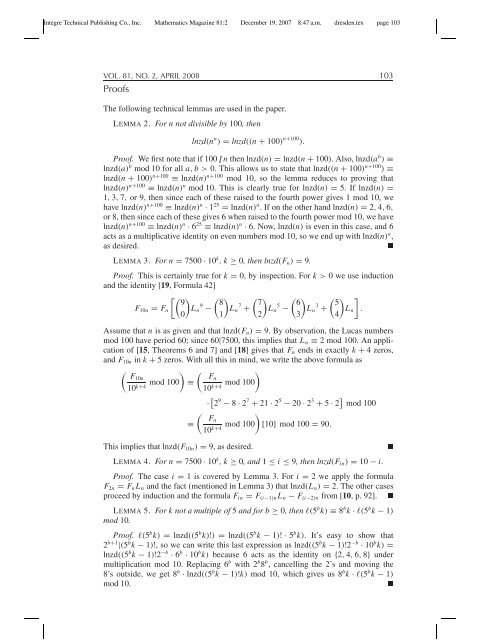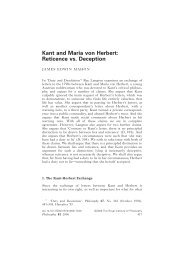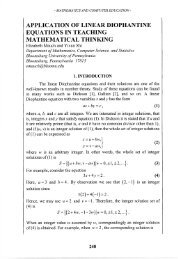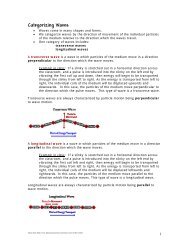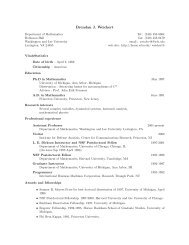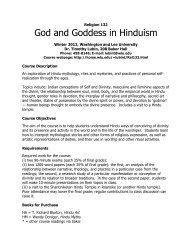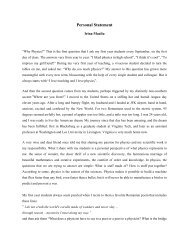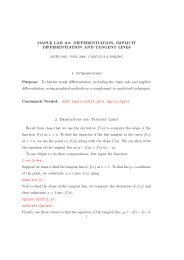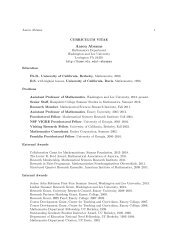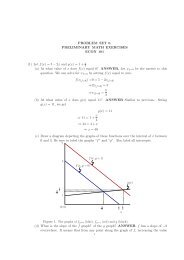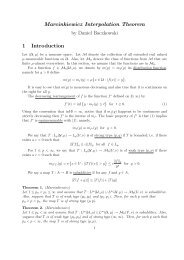Three Transcendental Numbers from the Last Non-Zero Digits of nn ...
Three Transcendental Numbers from the Last Non-Zero Digits of nn ...
Three Transcendental Numbers from the Last Non-Zero Digits of nn ...
Create successful ePaper yourself
Turn your PDF publications into a flip-book with our unique Google optimized e-Paper software.
Integre Technical Publishing Co., Inc. Ma<strong>the</strong>matics Magazine 81:2 December 19, 2007 8:47 a.m. dresden.tex page 103<br />
VOL. 81, NO. 2, APRIL 2008 103<br />
Pro<strong>of</strong>s<br />
The following technical lemmas are used in <strong>the</strong> paper.<br />
LEMMA 2. For n not divisible by 100, <strong>the</strong>n<br />
lnzd(n n ) = lnzd((n + 100) n+100 ).<br />
Pro<strong>of</strong>. We first note that if 100 /| n <strong>the</strong>n lnzd(n) = lnzd(n + 100). Also, lnzd(a b ) ≡<br />
lnzd(a) b mod 10 for all a, b > 0. This allows us to state that lnzd((n + 100) n+100 ) ≡<br />
lnzd(n + 100) n+100 ≡ lnzd(n) n+100 mod 10, so <strong>the</strong> lemma reduces to proving that<br />
lnzd(n) n+100 ≡ lnzd(n) n mod 10. This is clearly true for lnzd(n) = 5. If lnzd(n) =<br />
1, 3, 7, or 9, <strong>the</strong>n since each <strong>of</strong> <strong>the</strong>se raised to <strong>the</strong> fourth power gives 1 mod 10, we<br />
have lnzd(n) n+100 ≡ lnzd(n) n · 1 25 = lnzd(n) n . If on <strong>the</strong> o<strong>the</strong>r hand lnzd(n) = 2, 4, 6,<br />
or 8, <strong>the</strong>n since each <strong>of</strong> <strong>the</strong>se gives 6 when raised to <strong>the</strong> fourth power mod 10, we have<br />
lnzd(n) n+100 ≡ lnzd(n) n · 6 25 ≡ lnzd(n) n · 6. Now, lnzd(n) is even in this case, and 6<br />
acts as a multiplicative identity on even numbers mod 10, so we end up with lnzd(n) n ,<br />
as desired.<br />
LEMMA 3. For n = 7500 · 10 k ,k≥ 0, <strong>the</strong>n lnzd(F n ) = 9.<br />
Pro<strong>of</strong>. This is certainly true for k = 0, by inspection. For k > 0 we use induction<br />
and <strong>the</strong> identity [19, Formula 42]<br />
[( ) ( ( ( ( ]<br />
9 8 7 6 5<br />
F 10n = F n L 9 n − L n<br />
0 1)<br />
7 + L n<br />
2)<br />
5 − L n<br />
3)<br />
3 + n .<br />
4)L<br />
Assume that n is as given and that lnzd(F n ) = 9. By observation, <strong>the</strong> Lucas numbers<br />
mod 100 have period 60; since 60|7500, this implies that L n ≡ 2 mod 100. An application<br />
<strong>of</strong> [15, Theorems 6 and 7] and [18] gives that F n ends in exactly k + 4 zeros,<br />
and F 10n in k + 5 zeros. With all this in mind, we write <strong>the</strong> above formula as<br />
(<br />
F10n<br />
10 k+4 mod 100 )<br />
≡<br />
(<br />
Fn<br />
10 k+4 mod 100 )<br />
This implies that lnzd(F 10n ) = 9, as desired.<br />
· [2 9 − 8 · 2 7 + 21 · 2 5 − 20 · 2 3 + 5 · 2 ] mod 100<br />
( )<br />
Fn<br />
≡<br />
10 mod 100 [10] mod 100 = 90.<br />
k+4<br />
LEMMA 4. For n = 7500 · 10 k ,k≥ 0, and 1 ≤ i ≤ 9, <strong>the</strong>n lnzd(F in ) = 10 − i.<br />
Pro<strong>of</strong>. The case i = 1 is covered by Lemma 3. For i = 2 we apply <strong>the</strong> formula<br />
F 2n = F n L n and <strong>the</strong> fact (mentioned in Lemma 3) that lnzd(L n ) = 2. The o<strong>the</strong>r cases<br />
proceed by induction and <strong>the</strong> formula F in = F (i−1)n L n − F (i−2)n <strong>from</strong> [10, p. 92].<br />
LEMMA 5. For k not a multiple <strong>of</strong> 5 and for b ≥ 0, <strong>the</strong>n l(5 b k) ≡ 8 b k · l(5 b k − 1)<br />
mod 10.<br />
Pro<strong>of</strong>. l(5 b k) = lnzd((5 b k)!) = lnzd((5 b k − 1)! ·5 b k). It’s easy to show that<br />
2 b+1 |(5 b k − 1)!, so we can write this last expression as lnzd((5 b k − 1)!2 −b · 10 b k) =<br />
lnzd((5 b k − 1)!2 −b · 6 b · 10 b k) because 6 acts as <strong>the</strong> identity on {2, 4, 6, 8} under<br />
multiplication mod 10. Replacing 6 b with 2 b 8 b , cancelling <strong>the</strong> 2’s and moving <strong>the</strong><br />
8’s outside, we get 8 b · lnzd((5 b k − 1)!k) mod 10, which gives us 8 b k · l(5 b k − 1)<br />
mod 10.


